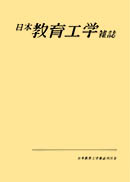Volume 24, Issue 2
Displaying 1-12 of 12 articles from this issue
- |<
- <
- 1
- >
- >|
-
Article type: Cover
2000 Volume 24 Issue 2 Pages Cover1-
Published: September 20, 2000
Released on J-STAGE: October 20, 2017
Download PDF (23K) -
Article type: Cover
2000 Volume 24 Issue 2 Pages Cover2-
Published: September 20, 2000
Released on J-STAGE: October 20, 2017
Download PDF (23K) -
Article type: Appendix
2000 Volume 24 Issue 2 Pages App1-
Published: September 20, 2000
Released on J-STAGE: October 20, 2017
Download PDF (22K) -
Article type: Article
2000 Volume 24 Issue 2 Pages 111-120
Published: September 20, 2000
Released on J-STAGE: October 20, 2017
Download PDF (1193K) -
Article type: Article
2000 Volume 24 Issue 2 Pages 121-132
Published: September 20, 2000
Released on J-STAGE: October 20, 2017
Download PDF (1299K) -
Article type: Article
2000 Volume 24 Issue 2 Pages 133-142
Published: September 20, 2000
Released on J-STAGE: October 20, 2017
Download PDF (1266K) -
Article type: Article
2000 Volume 24 Issue 2 Pages 143-152
Published: September 20, 2000
Released on J-STAGE: October 20, 2017
Download PDF (1151K) -
Article type: Appendix
2000 Volume 24 Issue 2 Pages App2-
Published: September 20, 2000
Released on J-STAGE: October 20, 2017
Download PDF (15K) -
Article type: Appendix
2000 Volume 24 Issue 2 Pages App3-
Published: September 20, 2000
Released on J-STAGE: October 20, 2017
Download PDF (89K) -
Article type: Appendix
2000 Volume 24 Issue 2 Pages App4-
Published: September 20, 2000
Released on J-STAGE: October 20, 2017
Download PDF (103K) -
Article type: Cover
2000 Volume 24 Issue 2 Pages Cover3-
Published: September 20, 2000
Released on J-STAGE: October 20, 2017
Download PDF (26K) -
Article type: Cover
2000 Volume 24 Issue 2 Pages Cover4-
Published: September 20, 2000
Released on J-STAGE: October 20, 2017
Download PDF (26K)
- |<
- <
- 1
- >
- >|
